Magazines and war
As the first mass media, magazines both played a vital role in shaping many people's views on and experience of war, and built their reputations and success on wartime sales. It was a symbiotic relationship over a hundred years and a pattern repeated in many countries outside Britain. In World War II, the very identity of the magazine was defined by the conflict and, while commercial pressures from the advent of television played a role, the loss of this 'Home Front' identity was part of their long-term demise.
- Magazines and the Boer wars
- Magazines in the Great War
- The Second World War
- Korea and Suez
- Vietnam and the Sunday supplements
- Quoting Magforum in your work
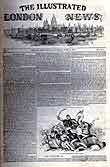 Illustrated London News from May 1842 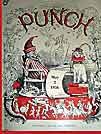 Punch magazine |
Magazines and the Boer warsThe middle of the nineteenth century was a revolutionary time for magazines with new printing technology, fast national distribution through the railways and industrialisation of the publishing process allowed the expansion of the industry. In particular, two magazines, Punch and the Illustrated London News, established two business models - the cartoon-based humorous weekly and the highly illustrated news weekly - that would have global influence. And driving demand from readers was news from the empire and a hunger for knowledge of Britain's role in the world. The hungry readership and growth in advertising funded the expansion of the ILN and its large format illustrated competitors such as such as the Graphic and the Sketch. Vital to this was the reporting - as both words and sketches - from the first Boer War. The first war, of 1880-1881, was sparked by the British annexation of the Transvaal in 1877 and the Boers revolted (so the war is also known as the Transvaal Rebellion). The second Boer War (1899-1902) broke out after Britain rejected Boer demands over arbitration in disputes and the withdrawal of its troops. Such was the demand for news that the war sparked the launch by Clement Shorter of the Sphere (1900), which used a similar format to the ILN and ran until 1964. Black & White Budget was another title devoted to war reporting, its smaller pages carried pages of small photographs, mainly from the Boer war. As former Sun newspaper editor Kelvin McKenzie has remarked, 'This was a great time to be British – after the drains (Bazalgette had connected most of London to the sewer network by 1866) and before the trenches (of the First World War).' |
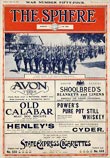 Sphere weekly, 14 August 1915 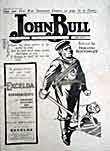 John Bull in 1916. At the start of the war, Bottomley revamped the cover image to dress the traditional John Bull figure in parts of the uniforms from the various armed forces |
Magazines in the Great WarThe outbreak of war brought the threat of catalclasym to the editor of London Opinion, Lincoln Springfield: ‘I should have thought a cataclysm such as that which started in August, 1914, would have killed any such journal as L.O. But, au contraire! Circulation slumped horribly in the first few weeks of the war, and advertising dropped alarmingly, but things gradually mended, and then improved, and then boomed, until to-day circulation and advertising, revenue and turnover are all at record heights.’ Springfield's experiences were related in the book Street of Ink (1917) and reflect those of many families and businesses during the war. His three sons went off to war, leaving his daughter, Jessie Springfield, to work as assistant editor, 'who is really every bit as good at the game as I, and perhaps better'. The magazine's leading cartoonists, Bert 'Arf a Mo Kaiser' Thomas and Alfred 'Kitchener / Your Country Needs You' Leete, both went off to fight with the Artists Rifles. 'We shall miss their splendid work tremendously,' said Springfield. 'Heaven help them if, after their innumerable jests at the expense of the Kaiser and "Little Willie", either of them should be taken prisoner!' The boom in sales for London Opinion came even though competition increased as several magazines devoted to the war were launched. These included the War Budget, published by the Daily Chronicle newspaper group as a weekly photographic record of the Great War; and War Illustrated, edited by John Hammerton. The latter carried a page illustration showing the exploits of one of the war's great heroes, Flora Sands (also spelt Sandes). Although women could not fight in most armies, Sands was a Scot who was a sergeant in the Serbian army. She is regarded as the only British woman to fight in WWI. She was wounded at the battle of Monastir but her bravery led the Prince Regent of Serbia to award her the Gold Cross of Kara George in 1917. |
|
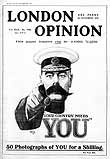 |
The Kitchener posterLondon Opinion's lasting contribution from the Great War is Alfred's Leete's artwork for an early wartime front cover, Your Country Needs You. The artwork was later used for several posters, published both by London Opinion itself and the government's recruiting agancy, the Parliamentary Recruiting Committee (PRC). Today, the image is an icon of the Great War. The story of Leete, Kitchener, the Your Country Needs You poster and the importance of magazines in wartime recruiting is told in the book Kitchener Wants You: The Man, the Poster and the Legacy by Martyn Thatcher and Anthony Quinn (Magforum founder). |
|
 |
'Old Bill' - Bystander's war heroThe illustrators in the popular magazines were well known to the public and created many popular characters. For example, Alfred Leete's Schmidt the Spy about the activities of an inept German spy, were very popular and made into a film. But the greatest cartoon hero came from the pen of a soldier serving at the front - Bruce Bairnsfather's 'Old Bill'. |
|
Blighty: a free magazine for the troopsunder development |
||
Uncle Sam mimics Kitchenerunder development |
||
The view from Parisunder development |
||
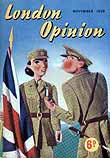 London Opinion switched its format to a pocket size and went monthly in November 1939 |
The Second World WarThe War Illustrated 1939/09/16 1 Ebay sep 07 99p + £1.60 "a permanent picture record of the second great war". 6d; 32pp. Centre 4 pages gravure. ed Sir John Hammerton (who edited WWI edition). DPS centre spread of Lancasters over Le Creusot Famous photos on cover victory in Egypt |
|
Picture PostUnder development |
||
Women at warUnder development |
||
Blighty revivedUnder development |
||
Marie Claire under the GermansUnder development |
Korea and SuezPicture Post killed off by a row over reporting the Korean War. |
Vietnam and the Sunday supplementsThe return of photojournalism |
Quoting MagforumI'm very happy for people to quote from Magforum pages - but you should acknowledge this by giving the Magforum page address and ideally adding a link to the page. All the material on Magforum is copyright - the site has taken a decade to build up and it's a one-man band, so you can imagine how how much time and effort has gone into it. Income from advertising pays for the site's fees, research costs and buying magazines. Referencing Magforum will benefit you and your website too, because:
If you are building a web page, note that you can often jump straight to the exact position on a page. For example, if you want to jump to the section above called 'The Second World War':
To cite this page in a dissertation:
|



